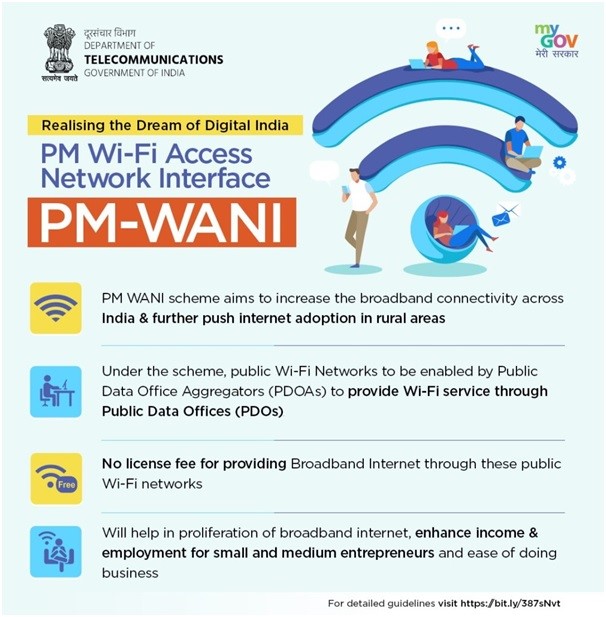PM-WANI: Revolutionizing Digital Connectivity Across Rural India
Why in the news?
The PM-WANI scheme, launched in 2020, aims to expand affordable public Wi-Fi in rural areas. By supporting local businesses and capping internet tariffs, it ensures digital inclusion and bridges the urban-rural digital divide.
Objective and Launch:
- PM-WANI (Prime Minister’s Wi-Fi Access Network Interface) was launched in December 2020 by the Department of Telecommunications.
- The scheme aims to expand public Wi-Fi hotspots, focusing on rural areas, to strengthen digital connectivity and reduce the urban-rural divide.
Operational Framework and Accessibility
- Local shops and small businesses are encouraged to establish Public Data Offices (PDOs) without any license or registration fees, providing affordable internet services.
- Users can access PM-WANI hotspots via an app to locate nearby networks, connect, and pay for the service.
- The ecosystem includes:
- PDOs: For setting up Wi-Fi hotspots.
- PDO Aggregators (PDOAs): Manage user data and authorization.
- App Providers: Facilitate seamless connectivity.
- A central registry managed by the Centre for Development of Telematics ensures smooth operations.
Benefits and Affordability
- Fosters employment opportunities for small entrepreneurs while providing low-cost internet to underserved urban poor and rural households.
- TRAI caps tariffs for Wi-Fi providers at twice the retail broadband rate, ensuring affordability for millions.
- PM-WANI is a step toward achieving digital inclusion and building a robust digital infrastructure for India.
National Digital Communications Policy (NDCP), 2018: Key Facts
- About: NDCP, 2018 aims to transform India into a digitally empowered economy by enhancing digital infrastructure and services.
- Goals: Deploy 10 million public Wi-Fi hotspots by 2022, provide broadband at 50 Mbps for all citizens, and ensure digital sovereignty.
- Key Objectives:
- Universal broadband access.
- Creation of 4 million jobs.
- Increase Digital Communications sector’s GDP contribution to 8%.
- Attract USD 100 billion in investments.
- Key Features:
- Expand Internet of Things (IoT) ecosystem.
- Focus on data protection, security, and accountability.
- Wi-Fi Hotspots Target: India achieved only 0.5 million hotspots, falling short of the 10 million target.
- Bharat 6G Vision (2030): Target 50 million public Wi-Fi hotspots, requiring significant growth and cost reduction.
This initiative empowers rural and underserved communities, enhancing access to information and fostering economic growth.
Sources Referred:
PIB, The Hindu, Indian Express, Hindustan Times




